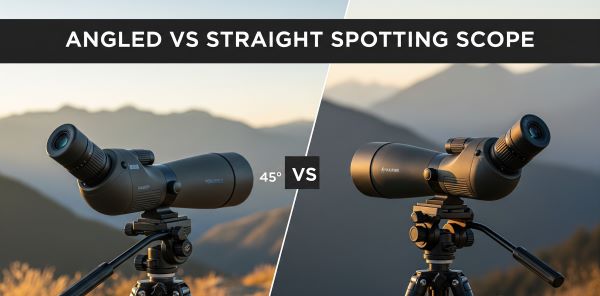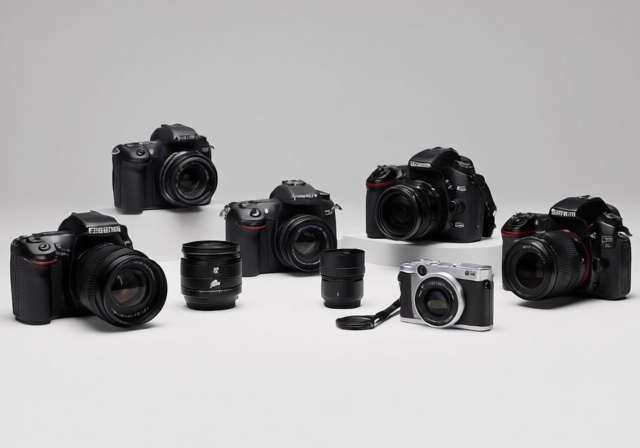



The debate between straight or angled spotting scope designs has divided hunters, birders, and outdoor enthusiasts for decades. Walk into any sporting goods store, and you’ll witness passionate discussions about which design reigns supreme. Yet, here’s what most people don’t realize: both designs deliver identical optical performance.
The real difference lies in ergonomics, comfort, and specific use cases. Whether you’re considering an angled spotting scope vs straight body for hunting, wildlife observation, or target shooting, your choice depends entirely on how and where you’ll use it. With both designs featuring the same 45-degree prism arrangement and virtually identical pricing, the decision comes down to matching the right tool to your needs.
This comprehensive guide breaks down every aspect of the right vs angled spotting scope debate. We’ll explore the advantages and limitations of each design, examine real-world applications, share professional tips, and provide a clear framework to help you make the perfect choice for your outdoor adventures.
Here’s the essential comparison to jumpstart your decision:
| Feature | Angled Spotting Scope | Straight Spotting Scope |
|---|---|---|
| Best For | Extended observation, steep terrain | Quick target acquisition, vehicle use |
| Comfort Level | Excellent for long sessions | Good for short-term use |
| Learning Curve | Moderate | Minimal |
| Tripod Height | 2-3 inches lower | Standard eye level |
| Window Mount | Challenging | Excellent |
| Target Finding | Requires practice | Intuitive |
| Sharing | Easy between users | Height-dependent |
Key Takeaway: Choose angled for comfort during extended glassing sessions and steep terrain. Choose straight for quick target acquisition, vehicle-based observation, and intuitive use.
The fundamental differences: • Angled scopes bend your viewing angle 45 degrees for ergonomic comfort • Straight scopes maintain a direct line of sight for natural viewing • Both designs offer identical magnification, clarity, and field of view
An angled spotting scope features an eyepiece positioned at a 45-degree angle from the main tube. This design redirects light through an additional prism, creating the characteristic bent viewing angle. Think of it as looking down into your scope rather than straight through it.
The angled design originated from astronomical telescopes, where observers needed comfortable viewing angles for extended stargazing sessions. Modern angled spotting scopes apply this same principle to terrestrial observation. The prism arrangement inside maintains full optical quality while providing ergonomic benefits.
Most quality angled scopes include a rotating collar feature. This allows the entire eyepiece assembly to rotate 360 degrees while maintaining your target in view. It’s this versatility that makes angled designs particularly popular among serious wildlife observers.
A straight spotting scope maintains a direct, in-line path from objective lens to eyepiece. Light travels straight through the optical system without angular deflection. This traditional design mirrors the configuration of rifle scopes and binoculars.
The straight design has military origins, dating back to battlefield observation needs. Soldiers required low-profile optics that allowed concealed observation from behind cover. This heritage explains why many hunters still prefer straight scopes for their tactical advantages.
The intuitive nature of straight scopes makes them immediately familiar to anyone who’s used binoculars. Point, look, and observe – it’s that simple. This natural alignment between your eye, the scope, and your target creates an instinctive viewing experience.
The ergonomic advantages of angled spotting scopes become apparent during extended observation sessions. Your neck remains in a neutral position, reducing strain during hours of glassing. This comfort factor alone converts many users to the angled design.
Lower tripod requirements offer both stability and convenience benefits. An angled scope positioned at chest height provides comfortable viewing, while a straight scope would need extending to eye level. This 2-3 inch height difference means less tripod extension and improved stability in windy conditions.
The rotating collar transforms an angled scope into a versatile observation tool. Multiple users of different heights can share the scope without adjusting tripod height. Simply rotate the eyepiece to accommodate each viewer’s position. This feature proves invaluable for group wildlife watching or when observing from awkward positions.
Uphill glassing scenarios strongly favor angled designs. When scanning ridgelines or observing birds in tall trees, the angled eyepiece prevents neck hyperextension. Mountain hunters particularly appreciate this advantage when glassing steep terrain for hours.
The learning curve represents the primary challenge for new angled scope users. Transitioning from binoculars requires retraining your target acquisition instincts. What looks natural through binoculars appears offset through an angled scope until you develop new muscle memory.
Window mount compatibility poses significant challenges for vehicle-based observation. The angled eyepiece often conflicts with vehicle interior geometry. Even with creative positioning, achieving a comfortable viewing angle from a driver’s seat proves difficult with most angled designs.
Storage and transport present minor but persistent inconveniences. The angled profile doesn’t slip easily into pack side pockets. The protruding eyepiece catches on gear and requires careful positioning to prevent damage during transport.
Extreme downhill observation angles challenge angled scope ergonomics. When glassing from clifftops or elevated positions, the eyepiece angle compounds the downward viewing angle. This forces uncomfortable body positions that negate the usual comfort advantages.
Intuitive operation makes straight spotting scopes ideal for beginners and casual users. The natural sight line from eye through scope to target requires no mental adjustment. This immediate familiarity accelerates the learning process and reduces frustration.
Seamless transitions from binoculars to spotting scope preserve your target acquisition. When you spot something interesting through binoculars, switching to a straight scope maintains the same viewing angle. This continuity proves crucial when tracking moving wildlife or relocating small distant objects.
Vehicle window mount applications strongly favor straight designs. The in-line viewing angle works naturally from a seated position. Professional guides and serious hunters often dedicate a straight scope specifically for vehicle-based observation.
Packing efficiency gives straight scopes a practical edge for backcountry adventures. The streamlined profile slides easily into pack pockets and doesn’t snag on vegetation. When every ounce and inch matters, straight scopes simplify your loadout.
Extended observation sessions reveal the ergonomic limitations of straight scopes. Maintaining proper eye alignment requires constant neck extension or awkward body positions. What starts as mild discomfort can develop into significant strain during all-day glassing sessions.
Taller tripod requirements create multiple disadvantages. Extended tripod legs catch more wind, reducing image stability. The higher center of gravity increases the risk of tipping. Premium tall tripods also add significant weight and cost to your system.
Sharing between users of different heights becomes problematic with straight scopes. Each person requires tripod adjustment to achieve proper eye alignment. This constant fiddling disrupts observation sessions and risks losing your target.
Upward viewing angles challenge straight scope ergonomics. Observing birds in flight or scanning ridgelines forces uncomfortable neck extension. This limitation becomes particularly apparent during extended observation of elevated subjects.
Stationary hunting setups maximize the comfort advantages of angled scopes. Whether glassing from a mountainside or observing from a blind, the ergonomic benefits compound over hours of patient watching. Professional guides often choose angled scopes specifically for client comfort during extended sessions.
Bird watching enthusiasts overwhelmingly prefer angled designs. The Audubon Society notes that angled scopes excel for observing birds in trees and during flight. The comfortable viewing angle encourages longer observation periods, leading to more successful sightings.
Range shooting applications benefit from angled scope stability and comfort. Competitive shooters appreciate maintaining their shooting position while checking targets. The lower tripod height also reduces interference with shooting benches and equipment.
Digiscoping photography works best with angled designs. The upward-facing screen angle simplifies camera alignment and adjustment. Most digiscoping adapters are optimized for angled scopes, reflecting their dominance in wildlife photography.
Mobile hunting from vehicles demands the versatility of straight scopes. Quick setup, intuitive aiming, and window mount compatibility make straight scopes indispensable for road-based scouting. Many hunters maintain a dedicated straight scope specifically for vehicle use.
Tree stand hunting favors straight scope ergonomics. The elevated position often requires downward viewing angles where straight scopes excel. The compact profile also navigates through branches more easily than angled designs.
Law enforcement and surveillance applications almost exclusively use straight scopes. The low-profile observation capability and rapid target acquisition prove crucial for tactical situations. Military heritage continues to influence modern tactical optics preferences.
Beginning spotters benefit from the immediate familiarity of straight scopes. The natural viewing angle reduces the learning curve and builds confidence quickly. Many experts recommend starting with a straight scope before considering angled designs.
Understanding the technical similarities between designs helps focus your decision on practical factors. Both angled and straight versions of the same model share identical specifications:
| Specification | Impact on Choice |
|---|---|
| Optical Quality | No difference – same lenses and coatings |
| Magnification | Identical zoom ranges available |
| Field of View | Same width at all magnifications |
| Light Transmission | Equal brightness and clarity |
| Weight Difference | Typically less than 2 ounces |
| Length Variation | Usually under 0.5 inches |
| Price Point | Same cost for equivalent models |
The minimal physical differences between designs emphasize that your choice should focus on ergonomics and use patterns rather than optical performance. Modern manufacturing ensures both designs deliver exceptional viewing experiences.
Start by honestly evaluating where you’ll use your spotting scope most frequently. Vehicle-based observers should strongly consider straight scopes for their window mount compatibility. Backcountry hunters who glass for hours benefit from angled scope comfort.
Consider your typical observation duration. Quick scanning sessions favor straight scopes, while extended glassing rewards angled designs. Match your scope choice to your actual use patterns, not idealized scenarios.
Think about terrain characteristics in your hunting or observation areas. Steep mountainous terrain favors angled scopes for uphill glassing. Flatland or elevated position observers may prefer straight scope versatility.
Age and flexibility significantly impact scope preference. Younger users often adapt quickly to either design, while older observers frequently appreciate angled scope ergonomics. Existing neck or back issues strongly favor angled designs for comfort.
Evaluate your typical observation style. Do you prefer standing, sitting, or lying prone? Each position has optimal scope configurations. Angled scopes offer more flexibility across different positions.
Group dynamics matter when choosing a scope design. Families or guided groups benefit from angled scope sharing capabilities. Solo users can optimize for their personal preferences without compromise.
Existing tripod height influences scope selection. Tall tripods work well with straight scopes, while standard tripods pair better with angled designs. Consider upgrade costs when making your decision.
Pack space and weight constraints affect scope choice. Straight scopes generally pack more efficiently, while angled scopes may require dedicated protection. Evaluate your complete gear system for compatibility.
Budget for accessories varies between designs. Window mounts, cases, and digiscoping adapters often cost more for angled scopes due to lower production volumes. Factor these additional costs into your decision.
The “cable tie trick” revolutionizes angled scope target acquisition. Attach a small cable tie to your scope tube, pointing toward the objective lens. This creates a simple sight that helps align your scope with targets spotted through binoculars.
Optimal tripod positioning for angled scopes places the eyepiece at chest height when seated. This allows comfortable viewing without hunching. When standing, position the eyepiece at lower chest level for extended comfort.
Master the rotating collar for maximum versatility. Practice rotating while maintaining your target to accommodate different viewing positions. This skill proves invaluable when observing from vehicles or sharing with others.
Quick acquisition techniques focus on maintaining consistent eye relief. Practice the smooth transition from binoculars to scope while keeping your target centered. Develop muscle memory for this critical skill.
Proper height adjustment prevents fatigue with straight scopes. Set your tripod so the eyepiece aligns naturally with your eye when standing relaxed. Avoid stretching or hunching to reach the eyepiece.
Wind stability improves with proper leg positioning. Spread tripod legs wider and keep extensions minimal. Position one leg pointing toward your target for maximum stability during observation.
Assuming price differences between designs leads to poor decisions. Manufacturers price angled and straight versions identically, so cost shouldn’t influence your choice. Focus on functionality, not imaginary savings.
Ignoring your primary use case causes buyer’s remorse. Be honest about how you’ll actually use the scope. Choosing based on theoretical advantages rather than real needs leads to equipment gathering dust.
Buying without testing both designs risks disappointment. Visit retailers to handle both options before purchasing. Online reviews can’t replace personal experience with ergonomics and ease of use.
Overlooking the spotting scope pros and cons for your specific situation leads to suboptimal choices. Create a personal priority list ranking comfort, portability, and specific use cases. Let your unique needs guide your decision.
Premium Choice: The Swarovski ATX modular system represents the pinnacle of angled scope design. The revolutionary rotating collar and exceptional optics justify the investment for serious observers.
Mid-Range Excellence: Vortex Viper HD angled models balance performance with value. The smooth focus wheel and included rotating collar make this a versatile choice for hunters and birders alike.
Budget-Friendly Option: Vortex Crossfire HD angled scopes deliver surprising quality at entry-level prices. While lacking some premium features, the optical quality exceeds expectations for casual users.
Premium Choice: Swarovski STX modules pair with the same objective lenses as ATX models. This modular system allows future conversion between designs, protecting your investment.
Proven Performer: Leupold Gold Ring straight scopes earn praise for rugged reliability. The straight-only design reflects Leupold’s commitment to hunting applications where straight scopes excel.
Value Leader: Consider the latest straight spotting scope review ratings when selecting budget options. Celestron and Bushnell offer capable straight scopes for occasional users.
Some manufacturers offer modular systems allowing eyepiece swapping. Swarovski’s ATX/STX system leads this category, though the additional eyepiece cost nearly equals buying a second complete scope. Most users find choosing one design more economical.
Hunting applications don’t universally favor either design. Stationary hunters glassing for extended periods prefer angled scopes. Mobile hunters who frequently relocate often choose straight scopes. Match your choice to your hunting style.
Birding often involves observing subjects at varying heights, from ground level to treetops. Angled scopes excel at upward viewing angles while maintaining comfort. The ability to use lower, more stable tripods also appeals to birders in windy coastal environments.
Quality manufacturers price both designs identically for equivalent models. Any price differences reflect retailer inventory management rather than manufacturing costs. Shop competitively for the best deals regardless of design choice.
Angled scopes dominate digiscoping due to easier camera alignment and screen visibility. The upward-facing camera screen remains visible for adjustment during photography. Most digiscoping accessories target angled scope users, providing better equipment options.
The angled vs straight spotting scope decision ultimately reflects your personal needs rather than inherent superiority of either design. Both deliver identical optical performance, leaving ergonomics and specific use cases to guide your choice.
Remember these key decision factors: Choose angled scopes for extended observation comfort, steep terrain glassing, and group sharing flexibility. Select straight scopes for vehicle-based observation, intuitive operation, and superior packability. Neither choice is wrong when matched to your actual needs.
Visit a sporting goods retailer to test both designs before purchasing. Handle each style, practice target acquisition, and simulate your typical viewing positions. Your personal comfort and use patterns matter more than any expert recommendation.
Whether you choose the versatility of angled spotting scopes or the intuitive operation of a spotting scope vs straight tube design, quality optics from reputable manufacturers will serve you well for decades. Invest in the best glass you can afford, choose the right design for your needs, and get out there to enjoy the incredible views that await.







